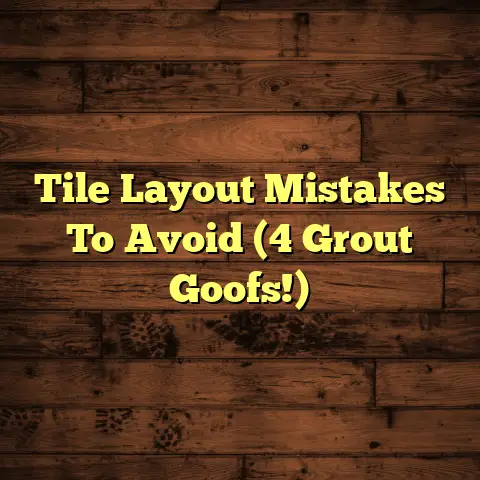Flooring Cost Estimator Netherlands (Explained)
Installing hardwood flooring is a significant investment that can enhance the beauty and value of your home. However, understanding the costs involved in this project is essential for making informed decisions. This article provides a detailed overview of the major cost factors impacting hardwood flooring installation in the Netherlands, including cost breakdowns, comparisons with alternative flooring options, and maintenance tips.
Major Cost Factors in Hardwood Flooring Installation
When estimating the cost of installing hardwood flooring, several factors come into play:
1. Area Size
The size of the area to be floored is one of the most significant cost determinants. Generally, costs are calculated per square meter. Larger areas may benefit from economies of scale, reducing the overall per-square-meter cost.
2. Hardwood Type
The type of hardwood selected significantly affects the overall price. Common types include:
- Oak: Popular and durable, typically priced between €30 – €70 per square meter.
- Maple: Known for its hardness and light color, generally costs around €40 – €80 per square meter.
- Cherry: Offers a rich color and is more expensive, usually ranging from €60 – €100 per square meter.
- Walnut: A premium option with a distinctive look, often priced at €90 – €150 per square meter.
- Engineered Wood: A more affordable alternative, averaging €40 – €70 per square meter.
3. Labor Costs
Labor is another crucial component of the overall cost. Professional installation typically ranges from €20 – €40 per square meter, depending on complexity and local rates. Factors influencing labor costs include:
- Experience level of the installers
- Installation method (e.g., nail-down, glue-down, floating)
- Removal of old flooring
4. Additional Considerations
- Floor Removal: Removing existing flooring can add costs, typically around €10 – €15 per square meter.
- Subfloor Replacement: If the subfloor is damaged, replacement can range from €15 – €25 per square meter.
- Material Grade: Higher-grade materials are more expensive but offer better aesthetics and durability.
- Room Size/Layout: Unusual layouts or additional features (like stairs) can increase installation costs.
- Installation Type: Complex patterns (e.g., herringbone) require more time and skill.
Detailed Cost Breakdown
Here’s a general breakdown of costs for different project sizes:
| Project Size | Hardwood Type | Estimated Cost (Material + Labor) |
|---|---|---|
| Small (20 m²) | Oak | €1,000 – €1,400 |
| Medium (50 m²) | Maple | €2,500 – €3,500 |
| Large (100 m²) | Walnut | €9,000 – €15,000 |
Hardwood vs Alternative Flooring Options
When considering flooring options, it’s important to compare hardwood with alternatives:
| Flooring Type | Cost per m² | Pros | Cons |
|---|---|---|---|
| Hardwood | €30 – €150 | Durable, aesthetic appeal | Higher initial cost |
| Laminate | €10 – €30 | Affordable, easy to install | Less durable than hardwood |
| Vinyl | €15 – €50 | Water-resistant, versatile | Can look less authentic |
| Carpet | €15 – €40 | Soft underfoot, warm | Difficult to clean |
Signs That Hardwood Floors Need Replacement
Over time, hardwood floors may show signs of wear and tear. Key indicators that replacement might be necessary include:
- Deep scratches and gouges that cannot be refinished.
- Extensive warping or buckling due to moisture damage.
- Persistent creaking or movement that signifies structural issues.
Refinishing vs. Replacement
Deciding whether to refinish or replace depends on the extent of damage and your budget:
- Refinishing: Suitable for minor wear; costs about €20 – €30 per m².
- Replacement: Necessary for extensive damage; costs significantly more.
Pros and Cons of Hardwood Flooring
Pros:
- Aesthetic Appeal: Adds warmth and beauty to any space.
- Durability: Can last for decades with proper care.
- Increases Property Value: Well-maintained hardwood can enhance home value.
Cons:
- Cost: Higher upfront investment than other flooring types.
- Maintenance: Requires regular care to maintain appearance.
- Susceptibility to Water Damage: Not ideal for wet areas without proper treatment.
Professional Installation vs. DIY
While DIY installation may save money, it’s essential to consider:
- Tools Required: Proper tools like saws and nail guns can be costly.
- Skill Level: Inexperience can lead to costly mistakes.
- Time Commitment: Professional installers can complete projects much faster.
Cost Analysis
Professional installation typically adds about 30% to the material cost but ensures quality and longevity.
Questions to Ask Hardwood Flooring Contractors
When hiring a contractor, ask the following:
- What types of hardwood do you recommend for my project?
- Can you provide a detailed written estimate?
- What is your experience with installing hardwood?
- How do you handle moisture issues?
- What warranties do you offer on products and workmanship?
Hardwood Floor Care and Maintenance Tips
To maximise the longevity of your hardwood floors:
- Regular Cleaning: Sweep or vacuum weekly to remove dirt and debris.
- Avoid Excess Moisture: Use a damp mop instead of soaking wet cleaning methods.
- Use Protective Pads: Place pads under furniture to prevent scratches.
- Refinish as Needed: Schedule refinishing every 5-10 years based on wear.
Conclusion
Estimating the cost of installing hardwood flooring involves multiple factors, including material choice, area size, labor costs, and additional considerations such as subfloor conditions. By understanding these elements, comparing options, and asking the right questions, you can make an informed decision that best suits your needs and budget. Whether you choose professional installation or take on a DIY project, proper care and maintenance will ensure your hardwood floors remain beautiful and durable for years to come.





